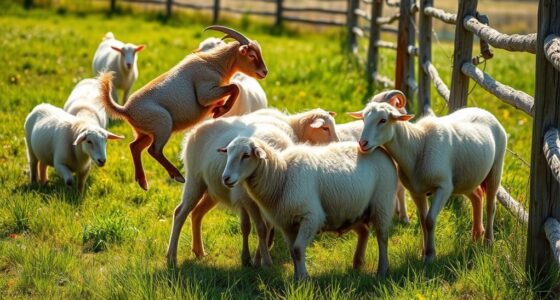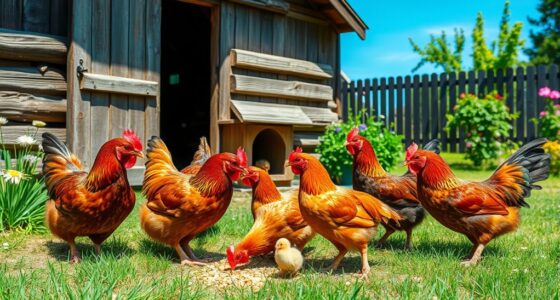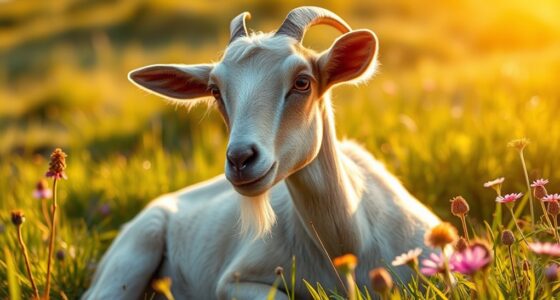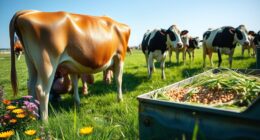Goats typically stay pregnant for 145 to 155 days, averaging around 150 days. Factors like breed size and environmental conditions can influence the length of pregnancy. You'll notice signs of pregnancy like increased appetite, udder development, and lack of heat cycles. Nutrition is crucial during this time, especially in the third trimester, to ensure a healthy delivery. If you want to learn more about the stages and care involved in goat pregnancy, keep exploring!
Key Takeaways
- Goat gestation typically lasts between 145 to 155 days, with an average of around 150 days.
- Factors like breed size, parity, and environmental conditions can influence gestation length.
- Pregnancy is divided into three trimesters, each lasting about 50 days.
- Signs of pregnancy include failure to return to heat and increased appetite.
- Proper nutrition during the third trimester is crucial to prevent complications like pregnancy toxemia.
Understanding Goat Gestation Period
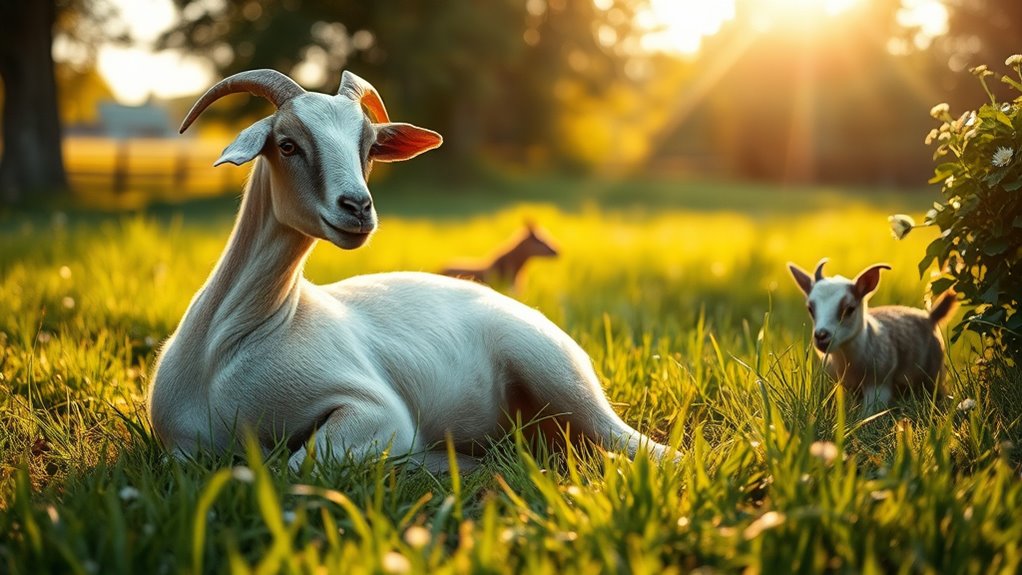
When you're raising goats, understanding their gestation period is crucial for successful breeding and kidding. Typically, goats carry their kids for about 145 to 155 days, averaging around 150 days. Factors like breed size, parity, and environmental conditions can influence this length.
During pregnancy, proper nutrition is vital, especially in the third trimester, to prevent issues like pregnancy toxemia. Keeping detailed records of breeding and kidding dates helps you manage future pregnancies effectively.
Proper nutrition during pregnancy, especially in the third trimester, is crucial to prevent complications like pregnancy toxemia.
Remember, goat pregnancy is divided into three trimesters, each lasting about 50 days. In the first two trimesters, nutritional needs are slightly above maintenance, while the third trimester demands a significant increase in nutritional quality to support the growing kids.
Regular health checks are essential throughout.
Signs of Pregnancy in Goats

Detecting pregnancy in goats involves observing several key signs that can indicate a doe is expecting. One of the first signs is a failure to return to heat, as pregnant does won't go into estrus.
You'll also notice an increased appetite due to rising nutritional needs. If you're milking her, watch for a decrease in milk production as her pregnancy progresses.
Physically, her abdomen will swell, and you may see udder development, especially in seasoned does. Behaviorally, she might become more withdrawn or restless.
As the pregnancy advances, you may even feel the kids moving around three to four months in. Keeping an eye on these signs can help you confirm her pregnancy effectively.
Pregnancy Stages and Nutritional Needs
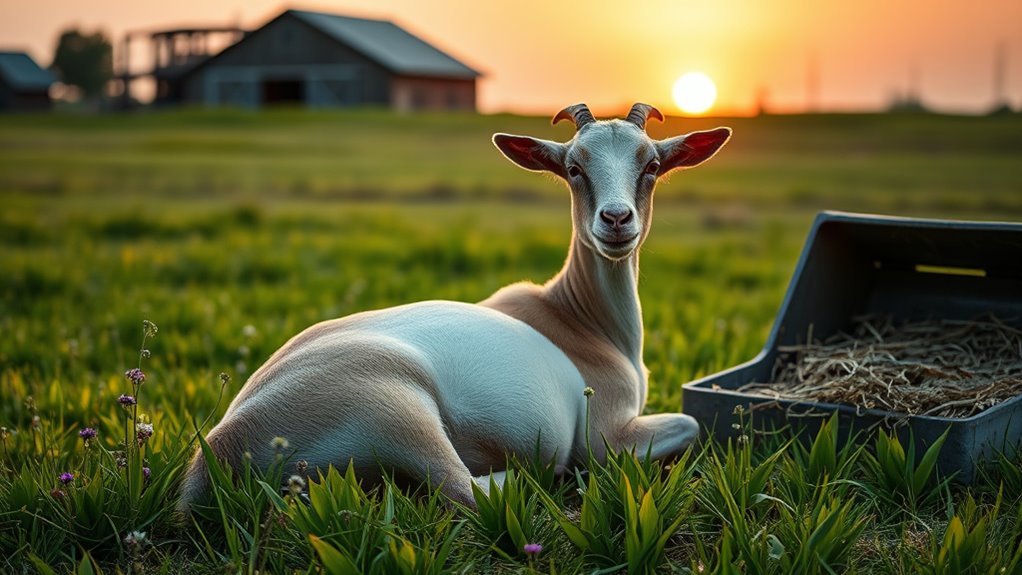
After confirming a goat's pregnancy, understanding the stages of gestation and her nutritional needs becomes vital. Goats typically carry their kids for 140 to 155 days, going through embryonic development, significant fetal growth, and preparation for birth.
In the last third of gestation, her energy and protein requirements increase significantly, especially for twins. During this time, a balanced diet rich in high-quality forage, calcium, and minerals is crucial.
Ensure she gets enough fresh, clean water, and consider supplementation to meet her elevated nutritional demands. Avoid overfeeding, as it can lead to complications during delivery.
Common Complications During Pregnancy
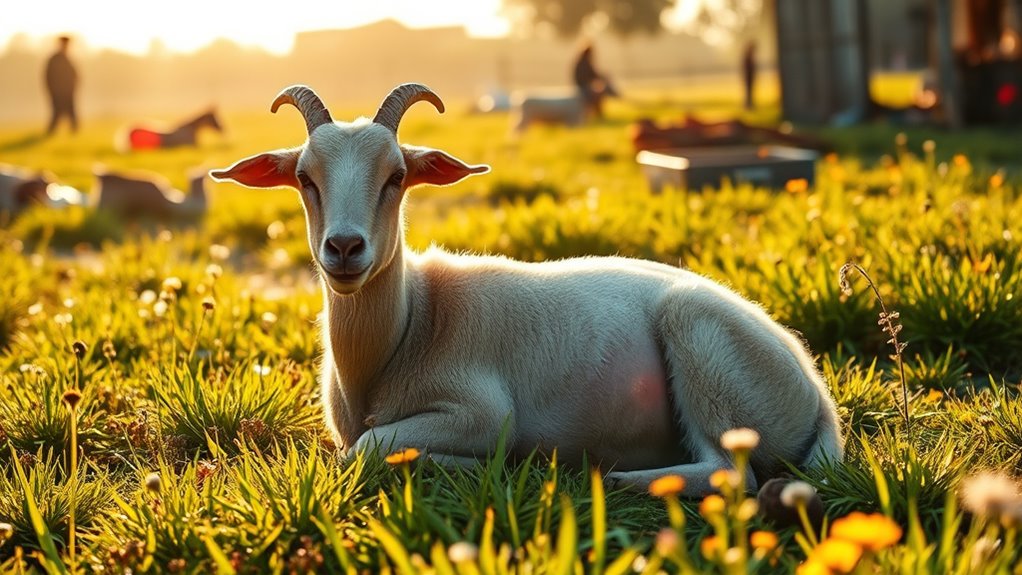
Although goat pregnancies are generally straightforward, several common complications can arise, impacting both the dam and her kids.
Retained fetal membranes affect about 26% of goats, with a 79% survival rate to discharge. Vaginal or perineal trauma occurs in 19% of cases, while uterine tears, a serious issue, affect 18% and have a 41% survival rate.
Metritis, or uterine inflammation, impacts 13% of goats, boasting a 64% survival rate. Perinatal mortality is also significant, with around 53% experiencing the loss of at least one kid.
Contributing factors include dystocia, nutritional deficiencies, and infectious diseases. Being aware of these complications can help you take preventive measures and ensure better outcomes for both the doe and her offspring.
Kidding and Post-Pregnancy Care

As you prepare for kidding and post-pregnancy care, it's essential to understand the stages and needs of both the doe and her kids.
Kidding typically lasts 1 to 12 hours, with signs like restlessness and tail raising indicating labor. After delivery, ensure the placenta is expelled completely to maintain the doe's health.
During freshening, provide high-quality feed to support recovery and milk production. Regular health checks are vital to catch any issues early.
During freshening, ensure the doe receives high-quality feed and regular health checks to promote recovery and optimal milk production.
Keep the doe with a companion to reduce stress, and manage colostrum for the kids carefully.
Frequently Asked Questions
Can Goats Experience False Pregnancies?
Yes, goats can experience false pregnancies, known as hydrometra. This condition causes fluid to accumulate in the uterus without a fetus, mimicking real pregnancy symptoms.
You might notice signs like a swollen abdomen and udder development. While false pregnancies can resolve on their own, it's essential to consult a vet for diagnosis and treatment options.
Regular check-ups help ensure your goat's health and prevent complications associated with untreated false pregnancies.
How Can I Tell if a Goat Is in Heat?
To tell if your goat is in heat, watch for signs like restlessness, vocalization, and acceptance of mounting.
The heat cycle lasts 18 to 21 days, with the standing heat phase lasting 12 to 24 hours. During this time, you'll notice increased activity and interest in other goats.
It's essential to breed during the standing heat for successful conception, so keep a close eye on her behavior during this period.
What Breeds Have the Longest Gestation Periods?
If you're curious about which goat breeds have the longest gestation periods, Alpine and Toggenburg goats top the list, averaging around 151 days.
Saanen goats follow closely, with a typical gestation of about 150 days.
Boer goats generally have shorter gestations at around 148 days.
Understanding these breed variations can help you prepare better for kidding and ensure proper care throughout the pregnancy.
Keep these details in mind for successful goat management!
Do Environmental Factors Affect Goat Pregnancy Duration?
Yes, environmental factors definitely affect goat pregnancy duration.
You'll notice that breed size plays a role, with smaller breeds often having shorter gestation periods.
Nutritional quality is crucial too; if you don't provide proper nutrition, it can lead to complications.
Stress from heat or poor conditions can also impact gestation length.
Keeping your goats in a stable, healthy environment will help ensure a smoother pregnancy and delivery.
How Often Can a Goat Breed in a Year?
Did you know that most goats are typically bred only once a year? This aligns with their natural breeding cycles, ensuring they remain healthy.
You can breed them more frequently, but it's usually not recommended due to health concerns and the potential strain on milk production.
If you're managing their breeding effectively, focus on quality over quantity to maintain strong genetics and overall well-being in your herd.
Conclusion
In conclusion, knowing that a goat's pregnancy lasts around 150 days can help you prepare for the arrival of adorable kids. Imagine, that's just a little over five months—a blink in the life of a goat! By recognizing the signs of pregnancy and providing proper care, you can ensure a smooth journey for both the mother and her newborns. Embrace this exciting time, and remember, every kid born adds a new chapter to your goat-keeping adventure!



